These disease-resistant varieties have come into their own in what winemakers in Central Europe keep telling me is a “strange”, “weird” or “extremely challenging” vintage, with the extremely hot and dry conditions of the summer followed by an extremely wet September. Charly says it’s been one of the toughest years for conventional grapes since the cool and wet 2014 and “you had to work hard” with them.
I’m back at BioWeingut Karl Renner, in southern Austria, to harvest the Souvignier Gris for my amber piwi blend. The late-ripening Souvignier Gris has good acidity and plenty of sugar (13.5% potential alcohol). I aim to blend it with the early-ripening Muscaris, picked two weeks ago and left on skins in two 350L amphorae. When this wine still had about 10-20g/L of sugar left, the skins were gently pressed and the wines were combined in a single amphora to complete their fermentation.
The Souvignier Gris is considered to be one of the best of the modern piwis – some say “the king of piwis”. It’s a pink-skinned grape with Seyval Blanc, Riesling and Traminer in its family tree.
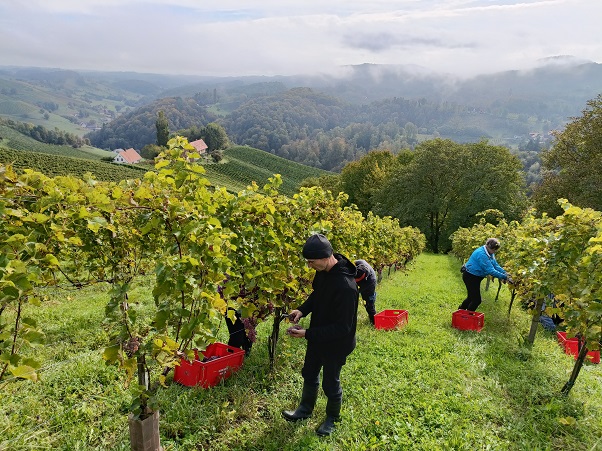
We begin picking in fog. But, as the fog lifts, I can see the beauty of the valley stretching away from the steep slope where the 0.5ha of Souvignier Gris grows amid Steiermark’s more conventional Vitis vinifera varieties, such as Sauvignon Blanc and Chardonnay.
Harvesting on the one dry day in a very wet week, the advantages of the new generation of piwis (from the German for fungal resistant, “pilzwiderstandsfähige”) are obvious.
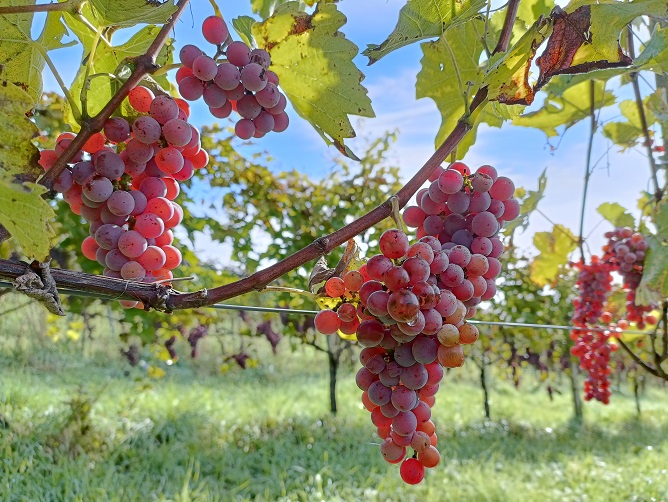
The Souvignier Gris grapes (above) look amazingly healthy after just one spray this year and are easy to see. Some of the leaves around the clusters were removed in the summer, but Souvignier Gris is less vigorous than the Muscaris growing on top of the hill. “The canopy is easier to manage,” Charly confirms. “Souvignier Gris, you need one hour to remove the leaves around the bunches, get the shoots in the wires – they are more erect than Muscaris. In the same size area, for Muscaris you need two or three hours.” Muscaris also produces a lot of suckers, and the vines need de-suckering a couple of times per season.
“Souvignier Gris – it’s not so much a jungle, it’s more free,” Charly adds.
About 10% has succumbed to botrytis, but these berries are now dry. The Muscaris grapes, picked two weeks earlier, were totally free of disease. Charly says Muscaris has “very high resistance”.
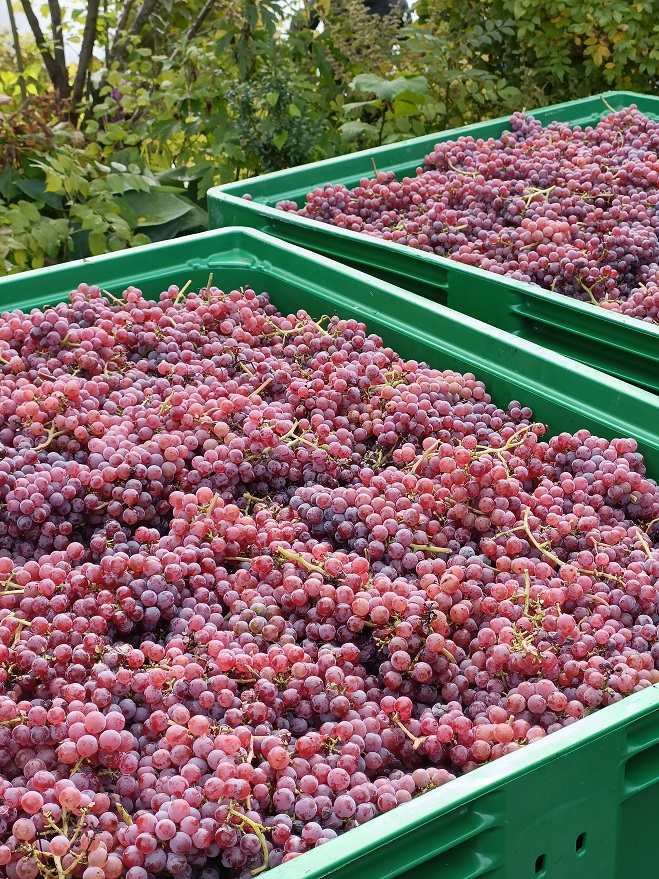
Picking piwis is a relatively quick affair. We only have to pick out the odd grape that has been attacked by an insect.
It takes our small team of five pickers from Slovenia plus the Renner family (Charly, wife Maria, father Erwin, mother Walpurga) and me four hours to collect six bin-loads. The one downside of the small berries and thick skins is the lower yield from each bunch. Charly reckons each bin will produce about 220L of wine – whereas for other varieties it would be more like 250-280L. In 2021, five bins of Souvignier Gris filled five barriques.
The crushed and destemmed grapes are destined for a mixture of amphora and stainless steel for fermenting and will be aged in amphora and oak barriques.
In 2021, BioWeingut Karl Renner’s Souvignier Gris spent three months on full skins and until August on 20-30% skins, when it was given a gentle squeeze in the pneumatic press. The colour is a golden yellow and there is no hint of the ‘gris’ colour in the wine, despite this extended period of maceration.
The plan is to use several components of Souvignier Gris in the final blend – some with 72 hours’ skin contact in the press, some with two- or three-weeks’ skin contact, and some with six months or longer.
“Souvignier Gris is a variety that can stay a long time on the skins,” Charly confirms. “Now we know six months is not too much.”
He adds: “What we have to do is learn how to handle it and which is the right way to make the wine. Skin contact? Yes. How long? Which vessel?”
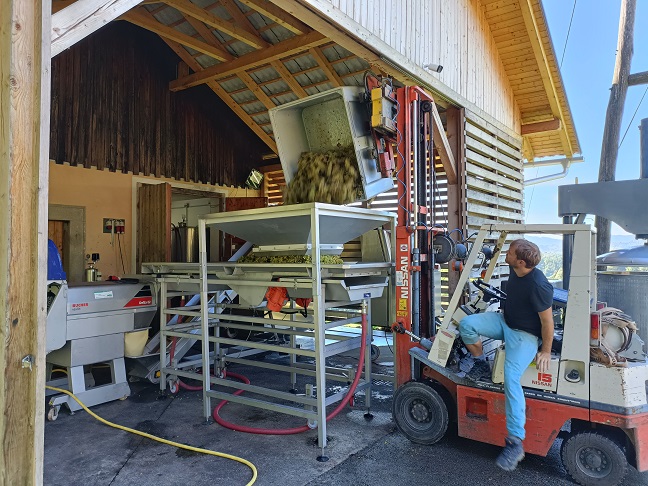
Of all the plans for my crazy #harvest2022 adventure – making eight wines in four countries in one vintage – this piwi project was the only one that was never in doubt; the only one I haven’t had to amend because of this “challenging vintage”.
In between the two piwi harvests, I went to the Haloze hills in Slovenia to make a white wine with a talented young winemaker, Michael Gross of Vino Gross (above). I wanted to make a skin-contact Furmint with him but when I arrived and saw the state of some bought-in Šipon/Furmint, we agreed it wouldn’t be wise to macerate these grapes. Instead, we are making an unusual white blend – a co-fermentation of free-run Laški rizling (Welschriesling) and whole Traminer berries. More about this wine next issue.
My plans to make a Kadarka (a light and spicy red wine) with three producers in different regions of Hungary, using three different technologies (oak, steel and Flexcube), has also been dampened by the rain. While I’m picking the piwi, one of the Kadarka producers calls to say they won’t have enough good quality grapes for my project…
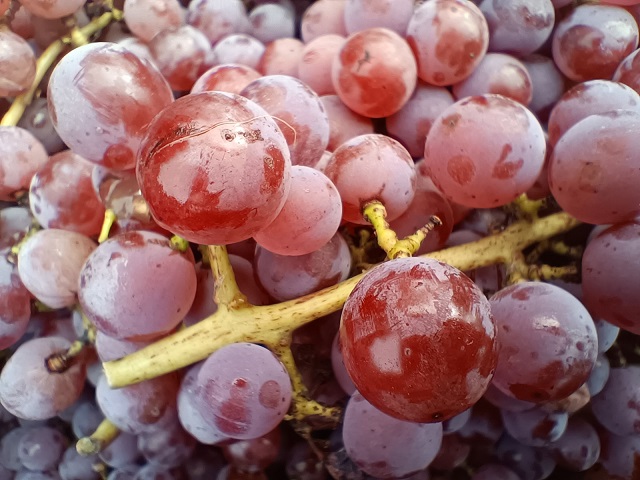
“Everything is out of balance,” Charly Renner observes, as we lunch with the picking team, overlooking the freshly-plucked vines. He’s talking about the weather in 2022.
I nod in agreement and marvel at the organic pink grapes in the bins (above), heading to BioWeingut Karl Renner’s small winery in Pössnitz. They look glorious. They look like the future to me. 2022 has proven they can cope with the weirdest and strangest growing conditions.
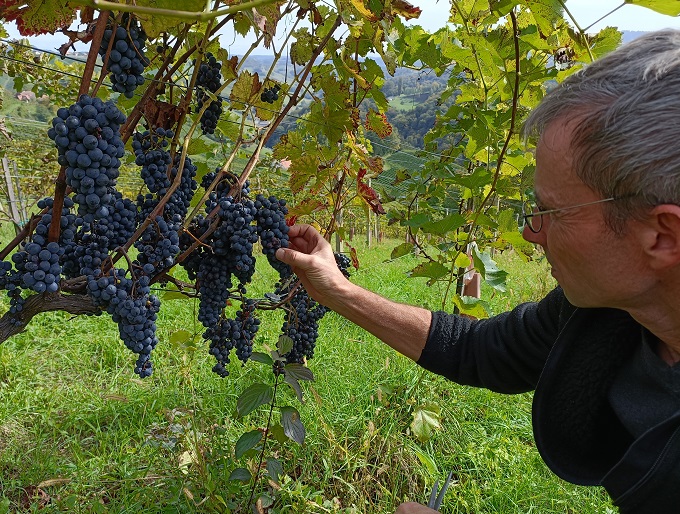
The last bin heading off is from the top rows of young vines, which replaced a piwi that didn’t work here: Cabernet Jura. Charly shows me the one Cabernet Jura vine that he didn’t replace (above). The red grapes are not worth picking. “It’s not so resistant. Very thin skin and early ripening,” Charly points out, before making a general observation about piwis and a plus-point for Souvignier Gris: “The disadvantage with piwis is: some of them are too early with the background of climate change. Souvignier Gris is the opposite – there is always enough acidity. First, I thought you have too much sugar and acidity but after two or three years I realise you need this acidity. It’s the spine of the wine.”
It will be the spine of my amber piwi creation.


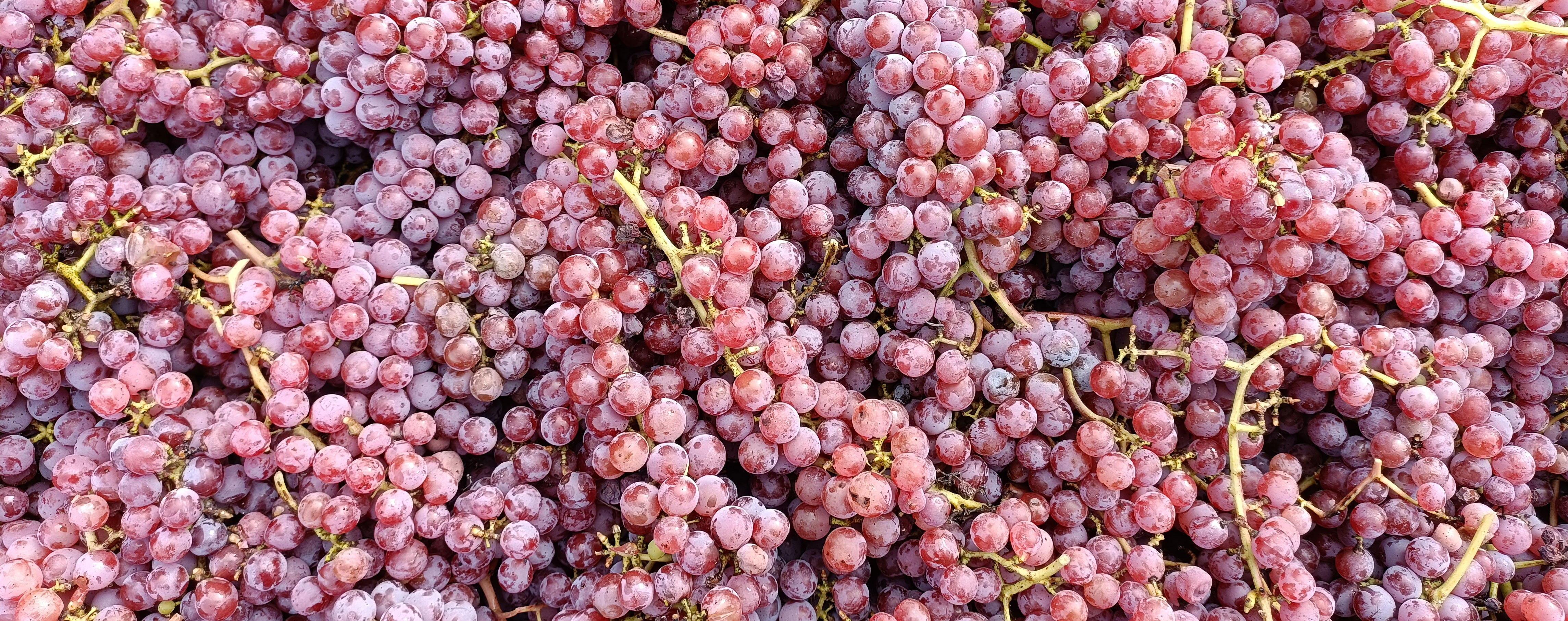










.png)






